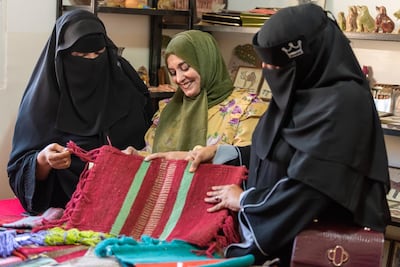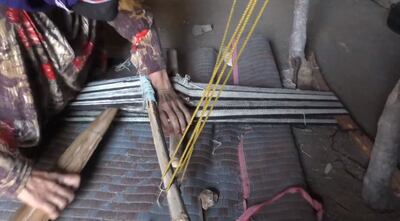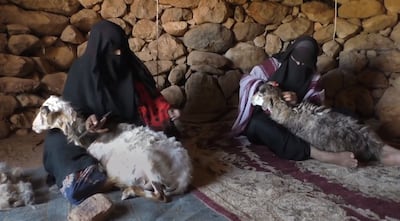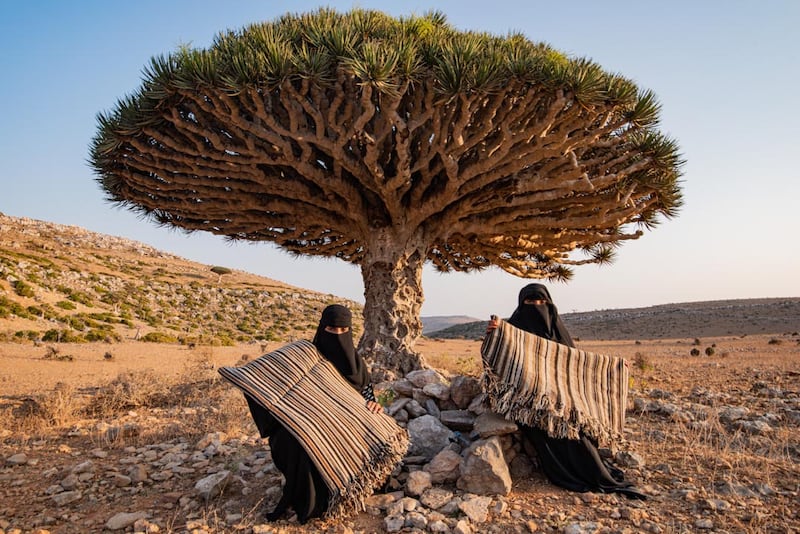Shaikhah Soliman and Ahdab Al Ameri each cradle a goat in their arms and gently cut off tufts of fur.
Later, they will thread it into spools of wool, before dyeing and weaving the coloured threads into a patterned carpet.
It's a centuries-old technique that the women, from Socotra, have been carrying out since childhood, and the duo are hoping it will remain long after their lifetimes.
As tourism to the Yemeni island increases, the two women are keen to showcase Socotra's traditional crafts. They opened the island's first handicrafts shop 10 years ago but are now seeking to reach a wider audience, with the aim of preserving traditional techniques.
Last month, Shaikhah, 39, and Ahdab, 36, were invited, along with other members of the Socotra Heritage Project team, to Amman to participate in a training programme organised by Jordan's Royal Society for the Conservation of Nature and the Royal Botanic Garden Edinburgh.

The intensive 18-day workshop was part of an initiative that seeks to promote sustainable development in Socotra while conserving the island's nature.
The workshop was part of a sustainable management programme run by the RSCN and RBGE on the Yemeni island. The main purpose of this collaboration was for Jordan's reserves to provide the Yemeni group with an on-the-ground insight into how to manage protected areas and to help develop their field experience.
The Yemeni women became involved in the preservation of culture 10 years ago when they worked together on a project that helped them set up a handicrafts shop for tourists.
With the aim of preserving the island's unique cultural heritage, they continued their interest by setting up workshops in the governorates of Hadiboh and Qalansiyah, which they now head.
“We have seen many workshops for handicrafts that have been established in the reserves as part of the socio-economic development programme for local communities,” said Shaikhah.
“Most of the workers were women from the local community.”

Over the course of the workshops, similarities in the crafting traditions of Jordan and Socotra emerged. But what impressed the Socotri women the most was the ability of the Jordanian women to produce high-quality crafts and market them locally and internationally.
Traditional carpet making in Jordan, like Socotra, uses a ground loom and natural products for dyeing the wool, although in many cases the natural colours of white and brown were used. Yemeni geographer Muhammad Al Hamdani, Socotri rugs and carpets were renowned for their quality, and formed one of Socotra’s primary exports, as far back as the 10th century.
“Carpets made on Socotra were recorded as being sold throughout the Indian Ocean from as far as the 13th century, owing to the better quality of the sheep that reflects in the quality of wool,” said archaeologist Julian Jansen van Rensburg, from the Socotra Heritage Project.
“Socotri wool has long been versatile, from making thick and hard carpets to place over the roof of their houses to stop wind and rain during the winter, to nice soft ones to wrap babies in.”
Making and selling Socotri crafts abroad is a goal that occupies the women's minds, and meeting with the Jordanians gave them valuable insight on how to achieve that, while preserving heritage and identity.
“We saw how their work has provided income-generating job opportunities in areas where opportunities are few for women in particular,” said Ahdab.

They were mostly impressed by how the Jordanian women modified some crafts to suit the requirements of the modern generation by making bags, carpets and pottery of different sizes in less traditional colours.
Their visit to Jordan's RSCN workshop reaped many valuable lessons for the women. They are now more determined than ever to overcome the many challenges ahead as residents of one of the most rudimentary islands in the region. “Jordan has made great strides in integrating the natural heritage with the cultural heritage,” said Shaikhah.
“The pottery which they manufacture using modern methods, now bear images of archaeological inscriptions, animals and plants native to their country, a practice we would like to implement in Socotra.”
Challenges remain
The small island of Socotra, about 340 kilometres south-west of Yemen, has long been known for its centuries-old, umbrella-shaped dragon blood trees, but changing temperatures and rising sea waters are putting its ecology, heritage and cultural traditions under threat.
Home to more than 60,000 people, it has remained relatively untouched by Yemen’s civil war, with Unesco describing the main island as one of the world’s “most biodiversity-rich and distinct”.
The war in Yemen, between the Houthis and pro-government forces backed by a Saudi-led coalition, since 2015 has only made the situation on the island more dire.
Traditionally, weaving on Socotra has been undertaken exclusively by women, who use a horizontal ground loom. These looms have been in use from approximately 4400BC, according to historical accounts, and are suited to the early nomadic lifestyle of the Socotri Bedouin.
“Traditional crafts of Socotra have a value that could contribute to development and livelihoods on the islands,” said Dr Alan Forrest, who works at the Centre for Middle Eastern Plants, part of Edinburgh's Royal Botanic Garden.
Yet, the biggest challenge that faces the Socotri women is the means to market, manufacture in larger numbers and export their goods.
Besides the bad internet connection, which makes online marketing, branding and selling near impossible, Shaikhah and Ahdab are trying to recruit the older women in the community to come into the institute a couple of times a month to pass on to younger generations the traditional crafting methods.
“Shaikhah and Ahdab are trying to grow the market beyond tourists in Socotra. We at the Socotra Heritage project are only there to assist and provide whatever help and advice they may need,” Dr Forrest said.
“They want to generate money and income that is supported and generated locally.” As such, the duo are not willing to give up on traditional design and techniques, and have refused to rely on modern sewing machines.
While the Socotra Heritage Project has been supported by the British Council since 2017, Shaikhah and Ahdab have been doing all of the heavy lifting.
“We don't do the work — it's about them. It's about their passion and dedication to preserve their heritage, we support them and their ideas and we try to fund them,” Dr Forrest said.
“It’s all there — they are waiting, they just need the means.”







